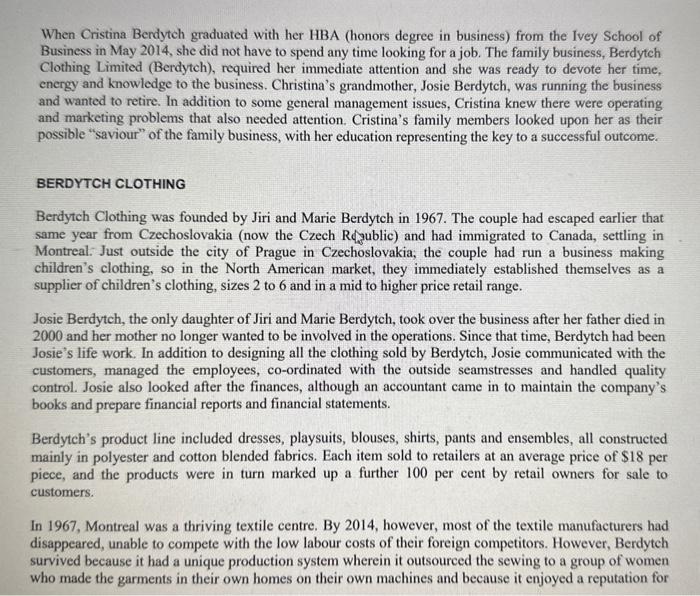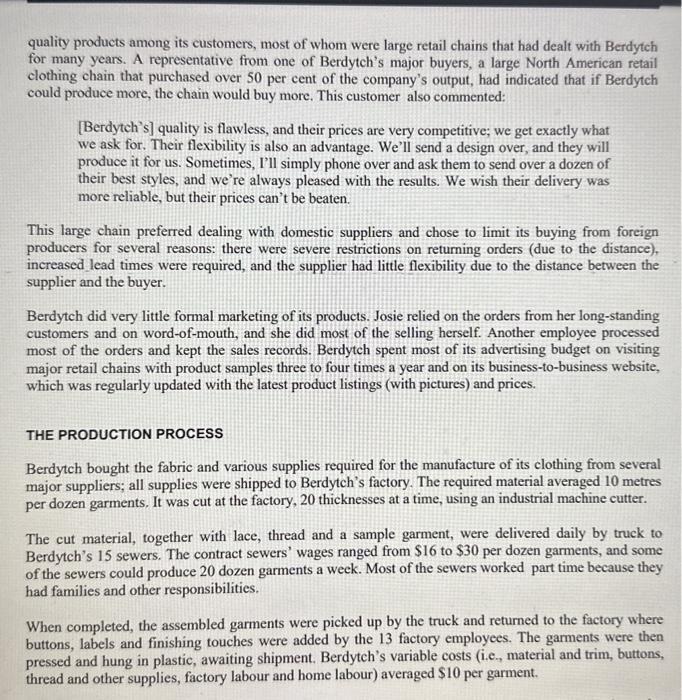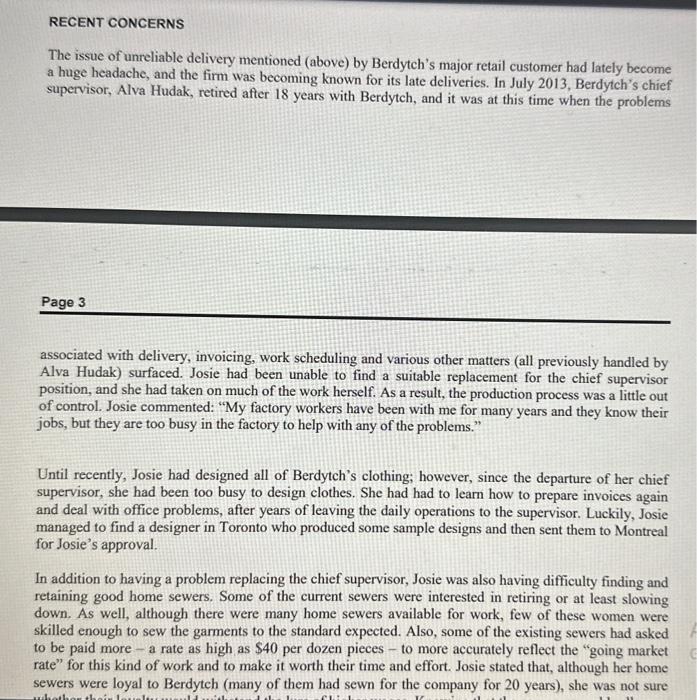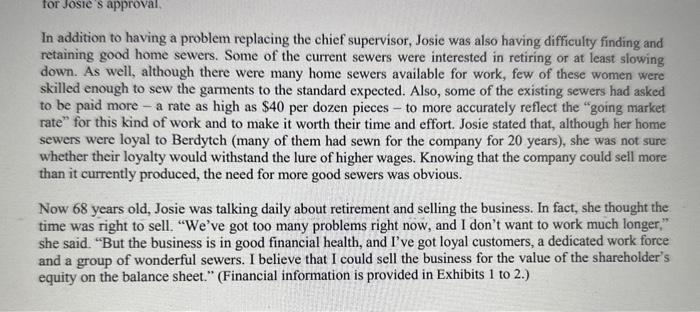Complete a SWOT analysis for Berdytch Clothing Limited. Explain how each reasoning
fits under each category. Response must be in paragraph format. (more than 500+ words answer please)

When Cristina Berdytch graduated with her HBA (honors degree in business) from the Ivey School of Business in May 2014, she did not have to spend any time looking for a job. The family business, Berdytch Clothing Limited (Berdytch), required her immediate attention and she was ready to devote her time, energy and knowledge to the business. Christina's grandmother, Josie Berdytch, was running the business and wanted to retire. In addition to some general management issues, Cristina knew there were operating and marketing problems that also needed attention. Cristina's family members looked upon her as their possible "saviour" of the family business, with her education representing the key to a successful outcome. BERDYTCH CLOTHING Berdytch Clothing was founded by Jiri and Marie Berdytch in 1967. The couple had escaped earlier that same year from Czechoslovakia (now the Czech Risublic) and had immigrated to Canada, settling in Montreal. Just outside the city of Prague in Czechoslovakia, the couple had run a business making children's clothing, so in the North American market, they immediately established themselves as a supplier of children's clothing, sizes 2 to 6 and in a mid to higher price retail range. Josie Berdytch, the only daughter of Jiri and Marie Berdytch, took over the business after her father died in 2000 and her mother no longer wanted to be involved in the operations. Since that time, Berdytch had been Josie's life work. In addition to designing all the clothing sold by Berdytch, Josie communicated with the customers, managed the employees, co-ordinated with the outside seamstresses and handled quality control. Josie also looked after the finances, although an accountant came in to maintain the company's books and prepare financial reports and financial statements. Berdytch's product line included dresses, playsuits, blouses, shirts, pants and ensembles, all constructed mainly in polyester and cotton blended fabrics. Each item sold to retailers at an average price of \$18 per piece, and the products were in turn marked up a further 100 per cent by retail owners for sale to customers. In 1967, Montreal was a thriving textile centre. By 2014, however, most of the textile manufacturers had disappeared, unable to compete with the low labour costs of their foreign competitors. However, Berdyteh survived because it had a unique production system wherein it outsourced the sewing to a group of women who made the garments in their own homes on their own machines and because it enjoyed a reputation for quality products among its customers, most of whom were large retail chains that had dealt with Berdytch for many years. A representative from one of Berdytch's major buyers, a large North American retail clothing chain that purchased over 50 per cent of the company's output, had indicated that if Berdytch could produce more, the chain would buy more. This customer also commented: [Berdytch's] quality is flawless, and their prices are very competitive; we get exactly what we ask for. Their flexibility is also an advantage. We'll send a design over, and they will produce it for us. Sometimes, I'll simply phone over and ask them to send over a dozen of their best styles, and we're always pleased with the results. We wish their delivery was more reliable, but their prices can't be beaten. This large chain preferred dealing with domestic suppliers and chose to limit its buying from foreign producers for several reasons: there were severe restrictions on returning orders (due to the distance), increased lead times were required, and the supplier had little flexibility due to the distance between the supplier and the buyer. Berdytch did very little formal marketing of its products. Josie relied on the orders from her long-standing customers and on word-of-mouth, and she did most of the selling herself. Another employee processed most of the orders and kept the sales records. Berdytch spent most of its advertising budget on visiting major retail chains with product samples three to four times a year and on its business-to-business website, which was regularly updated with the latest product listings (with pictures) and prices. THE PRODUCTION PROCESS Berdytch bought the fabric and various supplies required for the manufacture of its clothing from several major suppliers; all supplies were shipped to Berdytch's factory. The required material averaged 10 metres per dozen garments. It was cut at the factory, 20 thicknesses at a time, using an industrial machine cutter. The cut material, together with lace, thread and a sample garment, were delivered daily by truck to Berdytch's 15 sewers. The contract sewers' wages ranged from $16 to $30 per dozen garments, and some of the sewers could produce 20 dozen garments a week. Most of the sewers worked part time because they had families and other responsibilities. When completed, the assembled garments were picked up by the truck and returned to the factory where buttons, labels and finishing touches were added by the 13 factory employees. The garments were then pressed and hung in plastic, awaiting shipment. Berdytch's variable costs (i.e., material and trim, buttons, thread and other supplies, factory labour and home labour) averaged \$10 per garment. RECENT CONCERNS The issue of unreliable delivery mentioned (above) by Berdytch's major retail customer had lately become a huge headache, and the firm was becoming known for its late deliveries. In July 2013, Berdytch's chief supervisor, Alva Hudak, retired after 18 years with Berdytch, and it was at this time when the problems Page 3 associated with delivery, invoicing, work scheduling and various other matters (all previously handled by Alva Hudak) surfaced. Josie had been unable to find a suitable replacement for the chief supervisor position, and she had taken on much of the work herself. As a result, the production process was a little out of control. Josie commented: "My factory workers have been with me for many years and they know their jobs, but they are too busy in the factory to help with any of the problems." Until recently, Josie had designed all of Berdytch's clothing; however, since the departure of her chief supervisor, she had been too busy to design clothes. She had had to learn how to prepare invoices again and deal with office problems, after years of leaving the daily operations to the supervisor. Luckily, Josie managed to find a designer in Toronto who produced some sample designs and then sent them to Montreal for Josie's approval. In addition to having a problem replacing the chief supervisor, Josie was also having difficulty finding and retaining good home sewers. Some of the current sewers were interested in retiring or at least slowing down. As well, although there were many home sewers available for work, few of these women were skilled enough to sew the garments to the standard expected. Also, some of the existing sewers had asked to be paid more - a rate as high as $40 per dozen pieces - to more accurately reflect the "going market rate" for this kind of work and to make it worth their time and effort. Josie stated that, although her home sewers were loyal to Berdytch (many of them had sewn for the company for 20 years), she was not sure In addition to having a problem replacing the chief supervisor, Josie was also having difficulty finding and retaining good home sewers. Some of the current sewers were interested in retiring or at least slowing down. As well, although there were many home sewers available for work, few of these women were skilled enough to sew the garments to the standard expected. Also, some of the existing sewers had asked to be paid more - a rate as high as $40 per dozen pieces - to more accurately reflect the "going market rate" for this kind of work and to make it worth their time and effort. Josie stated that, although her home sewers were loyal to Berdytch (many of them had sewn for the company for 20 years), she was not sure whether their loyalty would withstand the lure of higher wages. Knowing that the company could sell more than it currently produced, the need for more good sewers was obvious. Now 68 years old, Josie was talking daily about retirement and selling the business. In fact, she thought the time was right to sell. "We've got too many problems right now, and I don't want to work much longer," she said. "But the business is in good financial health, and I've got loyal customers, a dedicated work force and a group of wonderful sewers. I believe that I could sell the business for the value of the shareholder's equity on the balance sheet." (Financial information is provided in Exhibits 1 to 2 .)










